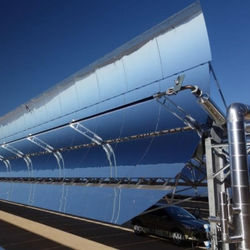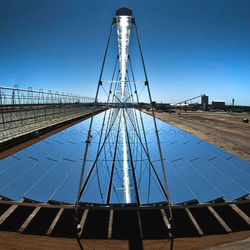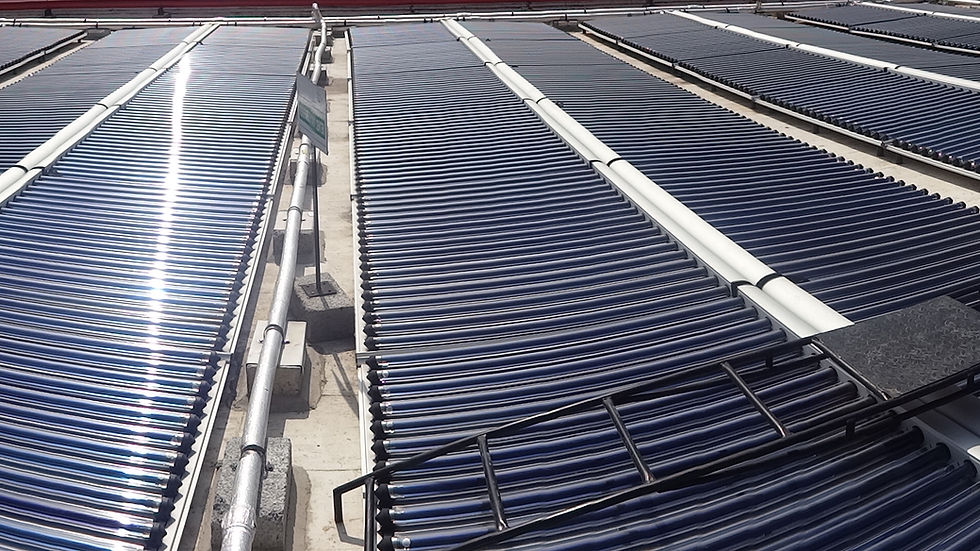USP of NatusSolar is a generation of hot water/steam using solar thermal energy up to 200°C for around 340 to 350 days a year.
Solar Thermal
Solar Thermal Energy collectors are special kinds of heat exchanges that transform solar radiation energy to heat energy using a transport medium.
The major component of any solar thermal system is the solar collector. This is a device that absorbs the incoming solar radiation, converts it into heat, and transfers the heat to a fluid (usually air, water, or oil) flowing through the collector.
The solar energy collected is carried from the circulating fluid either directly to the hot water or to a thermal energy storage tank, from which it can be sent for any required application.
Thermal collectors used by Natus Solar

Medium temperature collector

High temperature collector
Thermal collectors used world over
The following Non concentrating and Concentrating thermal collectors are used worldwide.
But all these have limitations in performance.
Non-concentrating collector systems
 Flat-plate-collector-technologyOperational temp 55-60 c Efficiency 20-25% Not effective in diffused or rainy conditions |  Evacuated tube collectorOperational temperature 50-120C Efficiency 35-45% Partially effective collector under diffused and rainy conditions |
|---|
Concentrating collector systems
 Parabolic trough collectorOperational temp 100-200 Efficiency 55% (at 200c) Not effective in diffused or rainy conditions |  Linear fresnel collectorOperational temperature 50-120C Efficiency 35-45% Not effective under diffused or rainy conditions |  Dish collectorOperational temperature > 250c Efficiency 50-60% Not effective under diffused or rainy conditions |
|---|
Limitations of these collector systems
-
All these systems have to track the sun in both directions, East to West from Morning to evening and North to the south over the year for effective collection of solar heat as they need direct sunshine and cannot be effective in angled sunlight.
-
This makes it very expensive and requires high maintenance.
-
These collectors do not function in diffused light if it is cloudy or raining.
-
Hence, they are effective only for 150 to 180 days a year depending on the location.
Medium temperature collector
High temperature collector
Evacuated tubes (ETC) with Compound Parabolic Reflector (CPC) Patented Design from Ritter, Germany.
This type of Collector is used to produce solar hot water up to 98 degree Celsius that can be used for solar air conditioning for the small and medium capacity requirements of up to 200 TR and where roof area is not a constraint, Medium temperature requirement of Solar Heat for Industrial Process (SHIP).
Key Features:
-
Low-pressure loss allows several modules to be connected in series
-
Minimum of soldering points ensures a high leakage safety
-
The well-known indestructibility of Ritter Solar tubes confirmed by the hailstone test DIN EN 12975-2
-
High energy yield in the transitional period and winter
-
In wintry conditions with a 400 W/m2 irradiation and 0 °C air temperature at a temperature of 20 °C, our evacuated tube collectors already have a higher energy yield than flat collectors
-
Extremely low heat loss due to the high vacuum
-
Outstanding design
High temperature collector
High temperature collector
Thermal Vacuum Power Charged a revolutionary, high-end, high-vacuum flat solar thermal panel designed as an ideal thermal energy source in the medium temperature range (100°C – 180°C) for Solar air conditioning, Solar Heat for Industrial Process (SHIP), desalination, Cold Storage and Solar Drying in commercial and industrial applications.
Key Features:
-
The unique combination of planar layout and high-vacuum insulation
-
Corrosion-proof all-metal casing
-
Embedded return HTF flow under high-vacuum
-
Made with materials qualified for long-lasting high-vacuum operation
-
Spot-Check visual vacuum verification
-
100% recyclable
Special features that make Natus collectors without the above limitation
The special mirror geometry ensures that even at unfavourable irradiation angles direct and diffuse sunlight falls onto the absorber. This substantially improves the energy yield of solar collectors. Due to the special fastening technique, the mirror can be exchanged without using tools.




Direct radiation

Angled radiation




